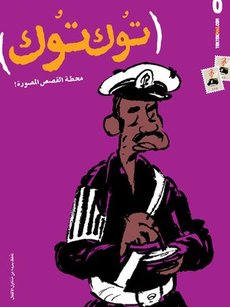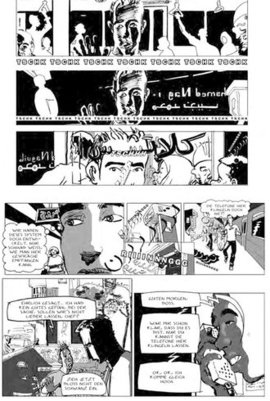Swimming against the Tide
This year's Erlangen International Comic Salon, which took place from 7 to 10 June, introduced a series of young comics artists from the Arab world and presented their work in a high-profile exhibition.
Hardly known at all in Europe until now, the work of these young artists has also been regarded in their homelands as peripheral to the art and cultural scene. As far as the general public in the Arab world was concerned, comics and animation films were for a long time nothing more than children's entertainment. To this day, only a small amount of people know that the genre can address topical, even explosive subject matter.
Initiatives such as the Egyptian comic magazine TokTok are trying to buck the trend. The publication was founded in early 2011 by a group of young graphic designers and illustrators with the aim of providing a vibrant forum for Egypt's nascent comic scene. As well as publishing new stories, the initiators also want to make a point of informing people about their predecessors in this art form.
Hand in hand with local traditions

This is why the very first edition, which was entirely self-financed, published an article about the illustrator and caricaturist Hegazi, one of the most significant caricaturists of the 1960s, who was known for his drawings about the hardships of the "little man on the street".
The creators of TokTok are particularly keen for people to understand that their art did not develop out of nowhere, that it is not simply copying Western models, but is clearly rooted in a domestic tradition.
There have also been other positive developments in recent years, one of which is the International Comic Festival, which has taken place in Algiers since 2008.
However, many countries in the region offer hardly any opportunities for publication. This is why the Internet plays an important role as a platform for disseminating work. This has been especially true since the Arab revolutions.
Alongside the advantages of extensive dissemination, the Internet also makes it possible to evade the state censorship with which many artists would otherwise come into conflict. The graphic novel Metro by the Egyptian artist Magdy El-Shafee was confiscated by the Egyptian censors a few weeks after it was published in 2008. The artist and the publishers were imprisoned and required to pay a steep fine upon their release.
Mirroring social problems
In the form of a detective story, the book took as its subject matter some of Egypt's social problems, such as poverty, misery and the widespread corruption among the elites, in other words, precisely the problems that sparked the protests at the beginning of 2011. Like so many other artistic endeavours that address these subjects and were created before the revolution, El-Shafee's work seems almost prophetic in retrospect.
But despite the social relevance and the recognition they sometimes receive (El-Shafee's works are displayed in the Townhouse Gallery, the best-known independent gallery in Cairo), most comics artists are dependent on other sources of income. Many therefore produce comics aimed primarily at children, work as graphic designers or pursue entirely different professions.
The situation is much the same in other Arab countries too. Despite the fact that there has been an active comic scene in Syria for many years, for example, not many graphic novels have been published there to date, and although there have been several attempts to start up a comic magazine for adults, these attempts have all ultimately failed due to a lack of sponsorship.
Ubiquitous censorship
The strict restrictions of media censorship also continue to create problems, which means that the protagonists in this sector have not succeeded in establishing a permanent platform for the genre. There is and hardly ever has been – either before the revolution or now – any support in Syria for non-commercial artistic projects that would give the artists the freedom to produce work independently of market interests.
For this reason, most Syrian comics artists continue to rely on media industry jobs, working for television or for private production firms that produce cartoons for children. The stories that are really close to their hearts – such as those drawn from the daily life of young Syrian people or their hopes and cares – have scarcely had the opportunity to reach their audience.
The Internet could change all that. Since the beginning of the protests in Syria, the Internet has increasingly been developing into a forum for creative artistic dissent and for a long time now, it has been far more than just a means of exchanging information.

For the online activists, graphics also have an important role to play alongside video. Moreover, many artists also use the Internet to declare their solidarity with the revolution and to condemn the violence in the country. This "discovery" of the Internet as a platform for the dissemination of artistic works is also giving fresh hope to Syrian comics artists.
The comics artist Salam Al-Hassan, who moved from Syria to Dubai two months ago and whose works were on display at the 15th Erlangen International Comic Salon, sees the increasing role of the Internet as providing new opportunities. "In the past, artists in Syria hardly used the Internet. That is now changing for the better, but we are still in the early stages; things still have to develop," says Al-Hassan.
The artist himself writes a blog where he presents his work and writes with great enthusiasm about the direct contact he believes comics are able to establish between the public and the artist.
Artistic balancing act
Like other artists in the region, the protagonists of the young Arab comic scene have to perform a balancing act. On the one hand, they have to entertain their audience and ensure that their work is also accessible to a broad readership, which is more usually guaranteed by a printed magazine than the Internet. On the other, they want to raise awareness of social and political problems and increase their public's sensibility towards these issues without being overly provocative of censorship, either political or societal.
Artists still face many restrictions. The Arab revolutions have given fresh impetus and new, immediate social relevance to this young art form. However, only time will tell whether in the long term, we will indeed see the hoped-for civil rights and freedoms and greater societal acceptance for which so many people took to the streets, and for which young people in particular have risked so much.
Charlotte Bank
© Qantara.de 2012
Translated from the German by Charlotte Collins
Editor: Aingeal Flanagan/Qantara.de
